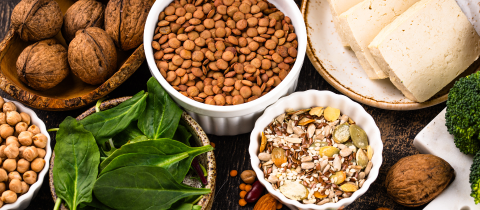Sometimes it is hard to enlist volunteers for a study, but I don’t think that will be the case for the appropriately named SPUD Project launched by researchers at the University of Surrey in the U.K. The volunteers will have the tough task of eating mashed potatoes prepared in various ways. Some potatoes will be stored at different temperatures before being boiled and then will be cooled to different temperatures before being reheated in the oven or the microwave! Some batches will have no fat added, others will be prepared with butter or with different vegetable oils. The goal is to determine the amount of “resistant starch” present in the mashed potatoes and the effect this has on blood glucose.
So, what does this starch resist? Digestion in the small intestine! At about 45% of daily calories, starch is the largest component of our diet. It is composed of amylose and amylopectin, both of which are long chains of glucose units, with amylopectin having a more branched structure. In food, the large starch molecules are curled up and compressed into “granules” that absorb water and swell when cooked, eventually bursting and releasing amylose resulting in increased viscosity. This is why sauces can be thickened by adding starch.
In the small intestine, enzymes break starch down into both smaller fragments and individual glucose molecules that are then absorbed into the bloodstream. From there, with the help of insulin, glucose enters cells where it can be used for energy. If blood glucose spikes after a meal, it may exceed insulin’s ability to deliver it into cells. This is a problem since elevated blood glucose in the short term can cause fatigue, hunger and mood changes, while in the long-term it can result in cardiovascular disease, type 2 diabetes and nerve damage.
Obviously, starch that resists digestion cannot release glucose into the bloodstream. So, what happens to it if it isn’t digested? The resistant starch travels to the colon as “fiber” where it meets up with bacteria that can break it down. The breakdown products include short-chain fatty acids such as butyrate that have a diversity of benefits ranging from reducing the risk of colon cancer to boosting the immune system.
The story of resistant starch begins back in 1985 with a paper in the American Journal of Clinical Nutrition that studied seven people who for various medical issues with their colon had to be fitted with bags to collect everything that would normally pass from the small intestine into the colon. The end of the small intestine, the ileum, is surgically retracted through an opening in the abdominal wall and is attached to an ileostomy bag that can be emptied. When the researchers analyzed the contents of these bags, they found that depending on whether the starch was ingested in the form of oats, cornflakes or white bread, up to 4% was recovered as starch, meaning it had not been digested and was therefore termed “resistant starch.”
Foods that contain resistant starch have the benefit of serving as fiber as well reducing glucose uptake meaning that increasing the resistant starch content of food is desirable. There are several ways to do this given that there are a number of ways that starch can be resistant to digestion. If starch molecules are bound within the cell walls of seeds, whole grains or legumes, digestive enzymes cannot get at them. But even in some cases where there is no such barrier to the enzymes, starch molecules may be folded in such a fashion that the enzymes cannot access all the bonds that need to be broken to release glucose. This is the case for green bananas and raw potatoes.
However, when bananas ripen, or when potatoes are cooked, the starch molecules unwind thereby increasing their digestibility. When such unwound molecules are cooled, they curl up again and form crystalline structures that resist digestion. That’s why a potato salad made from cooked and then cooled potatoes has more resistant starch than a boiled potato. The same goes for cooked and then cooled pasta or rice. In general, though, rice, pasta and potatoes are eaten without being cooled, so they will not have much resistant starch.
What happens though if these foods are cooled and then reheated? Will they still contain the resistant starch that formed upon cooling? That is exactly what the University of Surrey scientists want to find out. If it turns out that reheating maintains the resistant starch, then this will be a simple way for people to reduce glucose spikes and increase their intake of fiber.
The trial will also involve cooking the potatoes with different types of fat because some preliminary studies have shown that under the right conditions fats can bind to starch, making it resistant to digestion. This means that adding fat to the mashed potatoes would not only improve taste, it could also increase the resistant starch content. Maybe it will turn out that the best way to consume potatoes is by boiling, mashing, adding a bit of butter, cooling and then reheating. In the oven or in the microwave? The researchers are also trying to determine if that makes a difference. Of course, if you eat beans or lentils instead of potatoes you will get a lot more resistant starch and you won’t have to worry about cooking techniques.
Other scientists are taking a different approach to increasing the resistant starch content of the diet. The size of starch granules is a factor when it comes to digestibility. Smaller granules have a larger combined surface area than large granules so that digestive enzymes have greater access to their starch content. Larger granules therefore mean greater resistance to digestion. Generally, a higher ratio of amylose to amylopectin leads to larger granules. Editing of genes in wheat or corn, made possible by Nobel Prize winning CRISPR technology, can result in increasing the amount of amylose relative to amylopectin and result in flour and cornstarch with increased resistant starch content. These can then be used to improve the nutritional qualities of processed foods. Given the shadow that alarmists have cast over genetically engineered foods, researchers might have more difficulty enlisting volunteers to eat cereal that has been genetically engineered to contain more resistant starch than to dine on mashed potatoes. I would be game. Stay tuned.







